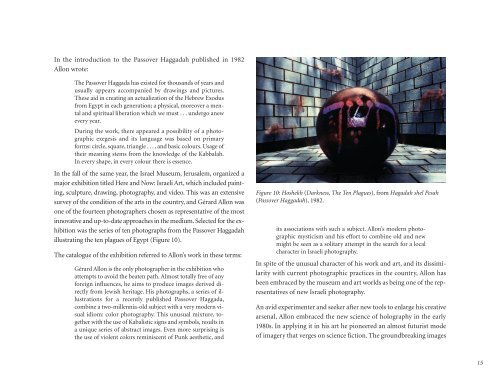Catalog of a Collection of Photographs by Gérard Allon in the Judaica Collection of the Harvard library
Create successful ePaper yourself
Turn your PDF publications into a flip-book with our unique Google optimized e-Paper software.
In <strong>the</strong> <strong>in</strong>troduction to <strong>the</strong> Passover Haggadah published <strong>in</strong> 1982<br />
<strong>Allon</strong> wrote:<br />
The Passover Haggada has existed for thousands <strong>of</strong> years and<br />
usually appears accompanied <strong>by</strong> draw<strong>in</strong>gs and pictures.<br />
These aid <strong>in</strong> creat<strong>in</strong>g an actualization <strong>of</strong> <strong>the</strong> Hebrew Exodus<br />
from Egypt <strong>in</strong> each generation; a physical, moreover a mental<br />
and spiritual liberation which we must . . . undergo anew<br />
every year.<br />
Dur<strong>in</strong>g <strong>the</strong> work, <strong>the</strong>re appeared a possibility <strong>of</strong> a photographic<br />
exegesis and its language was based on primary<br />
forms: circle, square, triangle . . . , and basic colours. Usage <strong>of</strong><br />
<strong>the</strong>ir mean<strong>in</strong>g stems from <strong>the</strong> knowledge <strong>of</strong> <strong>the</strong> Kabbalah.<br />
In every shape, <strong>in</strong> every colour <strong>the</strong>re is essence.<br />
In <strong>the</strong> fall <strong>of</strong> <strong>the</strong> same year, <strong>the</strong> Israel Museum, Jerusalem, organized a<br />
major exhibition titled Here and Now: Israeli Art, which <strong>in</strong>cluded pa<strong>in</strong>t<strong>in</strong>g,<br />
sculpture, draw<strong>in</strong>g, photography, and video. This was an extensive<br />
survey <strong>of</strong> <strong>the</strong> condition <strong>of</strong> <strong>the</strong> arts <strong>in</strong> <strong>the</strong> country, and Gérard <strong>Allon</strong> was<br />
one <strong>of</strong> <strong>the</strong> fourteen photographers chosen as representative <strong>of</strong> <strong>the</strong> most<br />
<strong>in</strong>novative and up-to-date approaches <strong>in</strong> <strong>the</strong> medium. Selected for <strong>the</strong> exhibition<br />
was <strong>the</strong> series <strong>of</strong> ten photographs from <strong>the</strong> Passover Haggadah<br />
illustrat<strong>in</strong>g <strong>the</strong> ten plagues <strong>of</strong> Egypt (Figure 10).<br />
The catalogue <strong>of</strong> <strong>the</strong> exhibition referred to <strong>Allon</strong>’s work <strong>in</strong> <strong>the</strong>se terms:<br />
Gérard <strong>Allon</strong> is <strong>the</strong> only photographer <strong>in</strong> <strong>the</strong> exhibition who<br />
attempts to avoid <strong>the</strong> beaten path. Almost totally free <strong>of</strong> any<br />
foreign <strong>in</strong>fluences, he aims to produce images derived directly<br />
from Jewish heritage. His photographs, a series <strong>of</strong> illustrations<br />
for a recently published Passover Haggada,<br />
comb<strong>in</strong>e a two-millennia-old subject with a very modern visual<br />
idiom: color photography. This unusual mixture, toge<strong>the</strong>r<br />
with <strong>the</strong> use <strong>of</strong> Kabalistic signs and symbols, results <strong>in</strong><br />
a unique series <strong>of</strong> abstract images. Even more surpris<strong>in</strong>g is<br />
<strong>the</strong> use <strong>of</strong> violent colors rem<strong>in</strong>iscent <strong>of</strong> Punk aes<strong>the</strong>tic, and<br />
Figure 10: Hoshekh (Darkness, The Ten Plagues), from Hagadah shel Pesah<br />
(Passover Haggadah), 1982.<br />
its associations with such a subject. <strong>Allon</strong>’s modern photographic<br />
mysticism and his effort to comb<strong>in</strong>e old and new<br />
might be seen as a solitary attempt <strong>in</strong> <strong>the</strong> search for a local<br />
character <strong>in</strong> Israeli photography.<br />
In spite <strong>of</strong> <strong>the</strong> unusual character <strong>of</strong> his work and art, and its dissimilarity<br />
with current photographic practices <strong>in</strong> <strong>the</strong> country, <strong>Allon</strong> has<br />
been embraced <strong>by</strong> <strong>the</strong> museum and art worlds as be<strong>in</strong>g one <strong>of</strong> <strong>the</strong> representatives<br />
<strong>of</strong> new Israeli photography.<br />
An avid experimenter and seeker after new tools to enlarge his creative<br />
arsenal, <strong>Allon</strong> embraced <strong>the</strong> new science <strong>of</strong> holography <strong>in</strong> <strong>the</strong> early<br />
1980s. In apply<strong>in</strong>g it <strong>in</strong> his art he pioneered an almost futurist mode<br />
<strong>of</strong> imagery that verges on science fiction. The groundbreak<strong>in</strong>g images<br />
15


